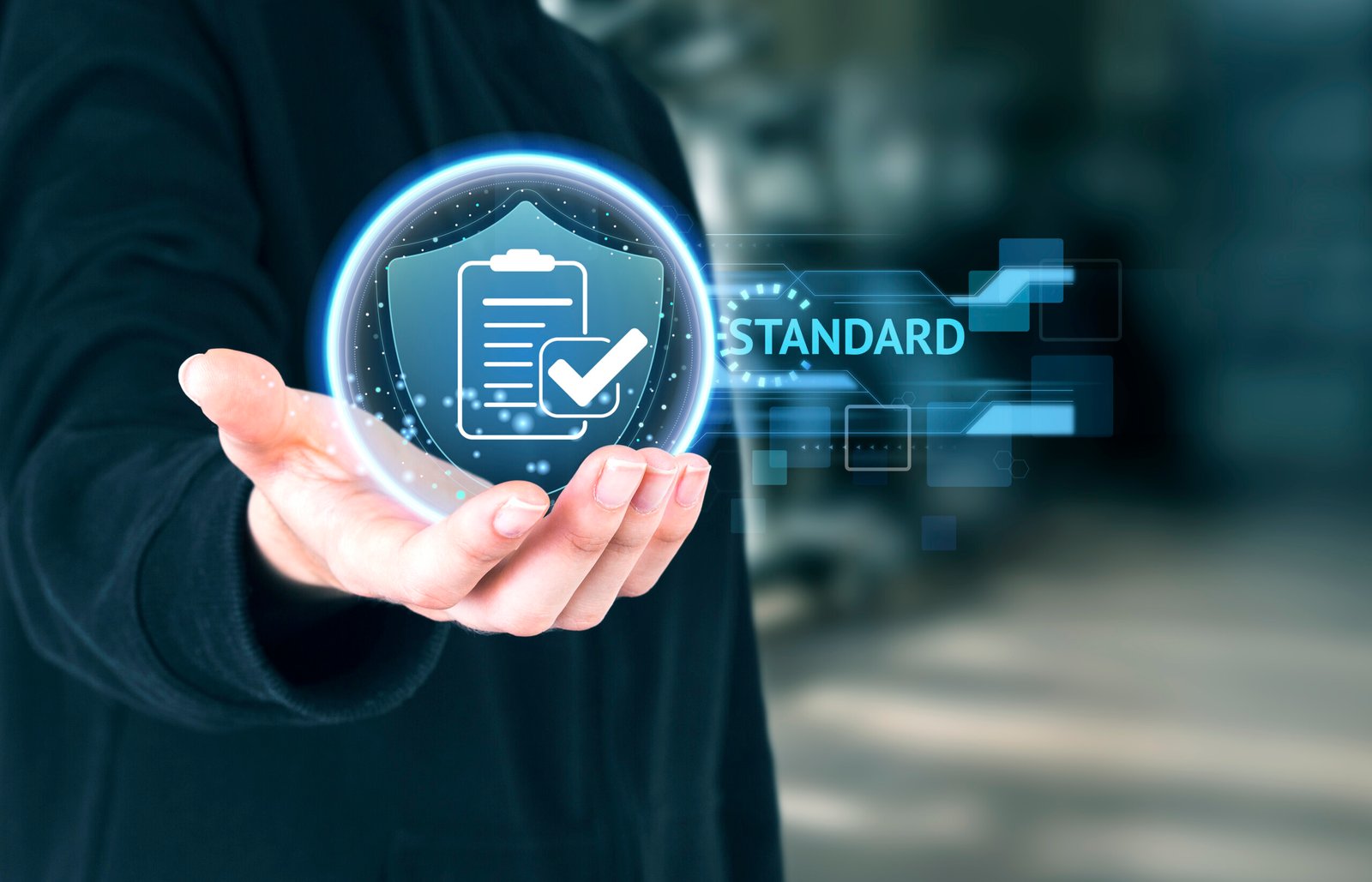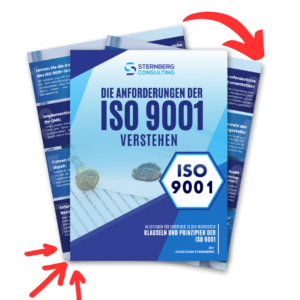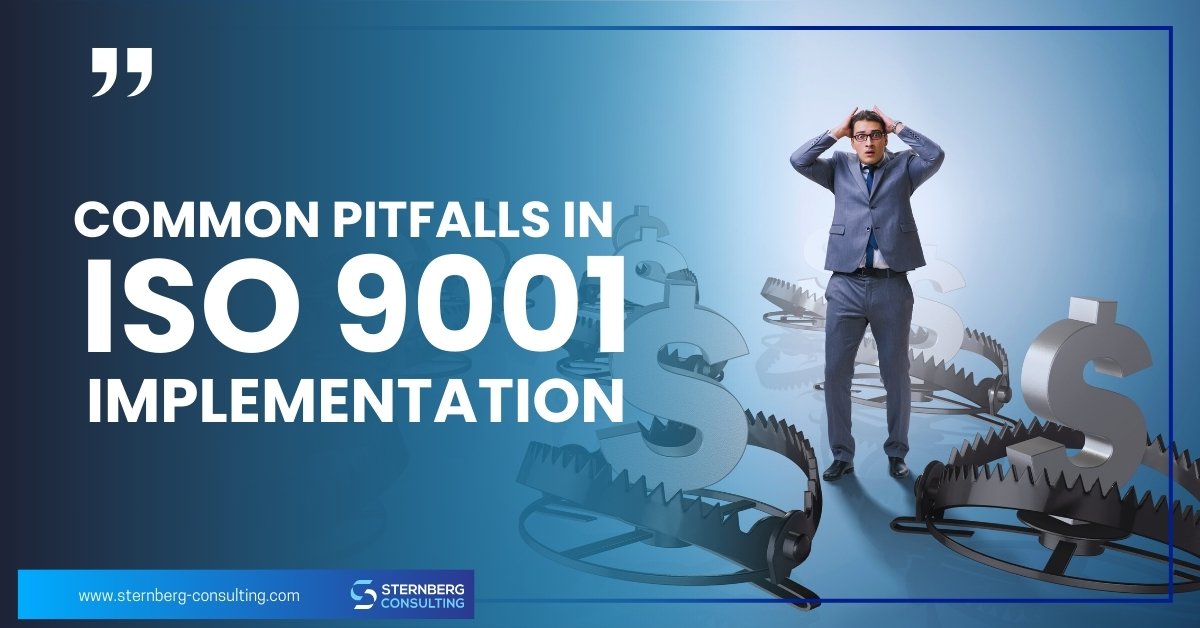
ISO 9001:2015 Requirements of the Standard Simply Explained
Quality management according to ISO 9001 explained in simple terms – easy to understand and apply the standard
Introduction: What is ISO 9001? – Simply explained
ISO 9001 is an internationally recognized standard for quality management systems (QMS). It specifies the requirements that a company must meet in order to establish and maintain an effective QMS. The main objective of ISO 9001 is to increase customer satisfaction through the consistent provision of products and services that meet customer requirements and applicable legal and regulatory requirements.
ISO 9001 is based on seven quality management principles: Customer Centricity, Leadership, People Involvement, Process Orientation, Improvement, Evidence-Based Decision-Making, and Relationship Management. By applying these principles, companies can optimize their processes, reduce errors, and continuously improve the quality of their products and services.
Significance and objectives of ISO 9001
ISO 9001 is the most widely used QM standard worldwide. It is industry-agnostic and can be used by organizations of all sizes. The main objectives of ISO 9001 are:
- Improve customer satisfaction by meeting customer requirements• Increase the efficiency and effectiveness of processes• Continuously improve QMS• Demonstrate the ability to consistently deliver compliant products and services.
By implementing ISO 9001, companies can strengthen their competitiveness, gain the trust of customers and improve their position in the market.
Benefits of Certification for Businesses
ISO 9001 certification offers numerous benefits to companies. These include:
- Improving customer satisfaction and loyalty• Increasing efficiency and productivity• Reducing errors and costs• Improving internal communication and collaboration• Increasing employee motivation and satisfaction• Improving the company’s image and competitiveness• Facilitating access to new markets
ISO 9001 certification allows companies to demonstrate to their customers, suppliers, and other interested parties that they have an effective QMS in place and are able to consistently deliver high-quality products and services.
The requirements of ISO 9001 at a glance
In this chapter, we summarize the core requirements of ISO 9001 before going into more detail about each chapter of the standard in the following sections.
The standard contains a total of 10 chapters and is structured according to the High Level Structure, with the first three chapters dealing with the scope of application, normative references and terms. The actual core requirements of ISO 9001 begin with Chapter 4 “Context of the Organization”:
- Context of the organization: Understanding the business environment, the needs and expectations of interested parties, and defining the scope of the QM system.
- Leadership: Commitment of top management, setting quality policies and objectives, and assigning roles, responsibilities, and powers.
- Planning: Identifying risks and opportunities, setting quality objectives, and planning for change.
- Support: Providing resources, ensuring competence, promoting awareness and governance of documented information.
- Operations: Planning, executing and controlling the processes for the provision of products and services.
- Performance Assessment: Monitoring, measuring, analyzing and evaluating the performance of the QM system, conducting internal audits and management evaluations.
- Improvement: Taking measures to continuously improve the suitability, appropriateness and effectiveness of the QM system.
By meeting these core requirements, organizations can build an effective quality management system based on a process-oriented approach, the Plan-Do-Check-Act (PDCA) cycle, and risk-based thinking. In the following chapters, we go into more detail about the individual sections of ISO 9001 and explain what companies need to do specifically to meet the requirements of the standard.
The quality management system according to ISO 9001
ISO 9001 focuses on a process-oriented quality management system that is based on the basic principles of quality management and focuses on continuous improvement.
Basic principles of quality management
ISO 9001 is based on seven basic principles of quality management:
- Customer centricity: Organizations depend on their customers and should understand and meet their needs and strive to exceed their expectations.
- Leadership: Leaders create alignment between the organization’s purpose and direction and should create the environment in which individuals are committed to achieving quality goals.
- Engaging people: At all levels, competent, empowered, and committed individuals are the essence of an organization.
- Process-oriented approach: Consistent and predictable results are achieved more effectively and efficiently when activities are understood and directed as interrelated processes.
- Improvement: Successful organizations have a continuous focus on improvement.
- Fact-based decision-making: Decisions based on the analysis and evaluation of data and information are more likely to lead to the desired outcomes.
- Relationship management: For continued success, organizations manage their relationships with relevant interested parties, such as suppliers.
Process-oriented approach
A key feature of ISO 9001 is its process-oriented approach. Organizations need to identify their processes, understand their interactions, and manage these processes to achieve the intended outcomes. By applying a process model, companies can:
- systematically understand and meet the requirements for the QMS,
- Consider processes in terms of value creation,
- Achieve the performance of processes, and
- Improve processes based on objective measurements.
Continuous improvement (PDCA cycle)
Another key element of ISO 9001 is continuous improvement. Organizations should continuously look for ways to improve their processes, products, and services. The PDCA cycle (Plan-Do-Check-Act) is often used for this:
- Plan: Set goals and establish processes necessary to achieve results in accordance with customer requirements and the organization’s policies.
- Do: Implement the planned processes.
- Check: Monitor and measure the processes and resulting products and services, as well as compare the results with the policies, goals and requirements, and report on the results.
- Act: Take action to continuously improve process performance.
By consistently applying the PDCA cycle, organizations can continuously optimize their processes, reduce errors, and increase customer satisfaction.
Context of the organization
An important aspect of ISO 9001 is understanding the context of the organization. Companies need to determine the internal and external issues that are relevant to their purpose and strategic direction and impact the ability to achieve the intended results of the quality management system.
Understanding the needs and expectations of interested parties
Organizations need to identify the interested parties that are relevant to the QMS and their requirements for the QMS. Interested parties may include:
- Customers
- Owner
- Colleague
- Suppliers
- Authorities
- Society
It is important to understand and monitor the requirements of the interested parties to ensure that the QMS is able to meet these requirements on an ongoing basis.
Defining the scope of the quality management system
The scope of the QMS must be defined and documented. This must take into account the external and internal issues, the requirements of the relevant interested parties, and the products and services of the organization. The scope should clearly describe the type of products and services, the locations and the processes covered by the QMS.
Quality Policy and Quality Objectives
The top management must establish a quality policy that:
- is appropriate for the purpose and context of the organisation;
- provides a framework for setting quality objectives;
- contains an obligation to comply with the applicable requirements, and
- includes a commitment to continuous improvement of the QMS.
The quality policy must be documented, communicated, understood and applied. Based on the quality policy, quality objectives must be set. These objectives must:
- are in line with the quality policy,
- be measurable,
- take into account the applicable requirements,
- be relevant for the compliance of products and services and the increase of customer satisfaction,
- be monitored,
- be communicated and
- updated as necessary.
The quality objectives should be defined and documented at the relevant functional and process levels. By understanding the context of the organization, the needs and expectations of interested parties, as well as establishing a clear quality policy and measurable quality goals, companies build a solid foundation for implementing and maintaining an effective ISO 9001 quality management system.
Management
Leadership plays a critical role in implementing and maintaining an effective ISO 9001 quality management system. Top management must demonstrate their leadership and commitment to the QMS.
Responsibility of the top management
The top management must take responsibility for the effectiveness of the QMS. This includes:
- Ensuring that quality policies and objectives are defined and consistent with the context and strategic direction of the organization
- Integration of QMS requirements into the organization’s business processes
- Promoting the process approach and risk-based thinking
- Ensuring the availability of the required resources for the QMS
- Communicate the importance of effective quality management and compliance with QMS requirements
- Ensuring that the QMS achieves its intended results
- Engaging, guiding and supporting people to contribute to the effectiveness of the QMS
- Driving improvements
- Supporting other relevant leaders to demonstrate their leadership in their areas of responsibility
Customer orientation
C-suite management must ensure that customer requirements, as well as applicable legal and regulatory requirements, are determined, understood, and consistently met. Risks and opportunities that may impact the compliance of products and services and the ability to increase customer satisfaction must be identified and addressed. The focus on increasing customer satisfaction must be maintained.
Roles, Responsibilities and Powers
C-suite management must ensure that responsibilities and authority for relevant roles within the organization are assigned, communicated, and understood. It must assign the responsibilities and powers to:
- Ensure that the QMS complies with the requirements of ISO 9001
- ensure that processes deliver the intended results
- Report on the performance of the QMS and on opportunities for improvement
- Promote customer centricity throughout the organization
- Ensure that the integrity of the QMS is maintained when planning and implementing changes to the QMS
By taking responsibility for the QMS, promoting customer centricity, and clearly assigning roles, responsibilities, and powers, top management creates the necessary conditions for an effective quality management system.
Planning
Planning is an essential part of the ISO 9001 quality management system. Organizations must plan the actions required to address risks and opportunities, achieve quality objectives, and plan for changes to the QMS.
Risks and opportunities
Organizations need to determine the risks and opportunities that need to be addressed to:
- ensure that the QMS can achieve its intended results
- amplify the desired effects
- Prevent or reduce undesirable effects
- Achieve improvements
Measures to deal with risks and opportunities must be planned and integrated into the processes of the QMS. The effectiveness of these measures needs to be assessed.
Quality objectives and planning to achieve them
Organizations need to set quality goals for relevant functions, levels, and processes. The quality objectives must:
- in line with the quality policy
- be measurable
- take into account the applicable requirements
- Be relevant for the compliance of products and services and the increase of customer satisfaction
- be monitored
- be communicated
- updated as necessary
When planning to achieve the quality objectives, the organization must determine:
- What is being done
- what resources are needed
- Who is responsible
- when it will be completed
- how the results are evaluated
Planning for changes
If the organization deems changes to the QMS necessary, these changes must be planned and implemented systematically. The organization must consider the following:
- the purpose of the changes and their possible consequences
- the integrity of the QMS
- the availability of resources
- the assignment or reassignment of responsibilities and powers
Through careful planning that takes into account risks and opportunities, quality objectives, and changes to the QMS, organizations can ensure that their quality management system remains effective and continuously improved.
Support
To maintain an effective quality management system, organizations must provide the necessary resources and create a supportive environment. This includes allocating resources, ensuring employee competence, fostering awareness of quality, and effective communication.
Resources
Organizations must identify and allocate the necessary resources to establish, maintain, and continuously improve the QMS. This includes:
- Personnel: Sufficient competent persons must be provided for the effective implementation of the QMS and the management of the processes.
- Infrastructure: The organization must provide and maintain the necessary infrastructure to carry out its processes, such as buildings, equipment, transportation, information and communication technology.
- Work environment: The working environment required to carry out the processes must be determined, provided and maintained. This can include physical, social, psychological, and environmental factors.
Competence and training
The organization must:
- Determine the required competence of the persons who, under their control, carry out activities that affect the performance and effectiveness of the QMS
- ensure that these individuals are competent on the basis of appropriate education, training or experience
- take measures, if necessary, to acquire the necessary competence and to assess the effectiveness of the measures taken
- Retain adequate documented information as proof of competency
Awareness and communication
The organization must ensure that the persons operating under the control of the organization are aware of the quality policy, the relevant quality objectives, their contribution to the effectiveness of the QMS and the consequences of non-compliance with the QMS requirements. The organization must determine the internal and external communications that are relevant to the QMS, including:
- What is being communicated about
- When to communicate
- Who you communicate with
- how to communicate
- Who communicates
Documented information
The organization’s QMS must include the documented information required by ISO 9001, as well as the documented information deemed necessary by the organization for the effectiveness of the QMS. The organization must ensure that the documented information is appropriately created, updated, available, protected, and governed. By allocating adequate resources, ensuring employee competence, fostering quality awareness, effective communication, and governance of documented information, organizations create a supportive environment for their quality management system.
Operation
Operations involve planning, executing, and controlling the processes required to deliver products and services. Organizations must ensure that these processes are carried out under controlled conditions to ensure compliance with the requirements.
Planning and control of processes
The organization must plan, implement, and control the processes required to deliver products and services. This includes:
- Defining the requirements for the products and services
- Establishing criteria for the processes and acceptance of products and services
- Determine the resources required to comply with product requirements
- Implementation of process control in accordance with the criteria
- Determining, maintaining, and retaining documented information to ensure that processes have been performed as planned and that products and services meet requirements
Requirements for products and services
The organization must determine the requirements for the products and services, including:
- Legal and regulatory requirements
- Requirements deemed necessary by the organization
The organization must ensure that it has the capability to deliver the products and services offered. Changes to the requirements must be reviewed and documented.
Development of products and services
The organization must establish a process for the development of products and services that ensures that the resulting products and services meet the set requirements. The development process needs to be planned and managed, including:
- Planning of the development stages
- Determination of verification and validation activities
- Determination of responsibilities and powers
- Management of the interfaces between the groups involved in the development
- Updating of development results and documented information
Control of externally provided processes, products and services
The organization must ensure that externally deployed processes, products, and services meet the established requirements. The type and scope of control must be determined, including:
- Ensuring that externally deployed processes remain under the control of the QMS
- Define the criteria for evaluating, selecting, monitoring performance and re-evaluating external vendors
- Carry out verification activities to ensure that the processes, products and services provided externally meet the requirements
By effectively planning, executing, and controlling operational processes, organizations ensure they deliver compliant products and services and meet the needs of their customers.
Evaluation of performance
Performance assessment is an essential part of the ISO 9001 quality management system. Organizations need to monitor, measure, analyze, and evaluate the performance and effectiveness of the QMS to identify areas for improvement and increase customer satisfaction.
Monitoring, Measurement, Analysis and Evaluation
The organization must determine:
- What needs to be monitored and measured
- the methods for monitoring, measuring, analysing and evaluating to ensure valid results
- when monitoring and measurement need to be carried out
- when the results of monitoring and measurement need to be analysed and evaluated
The organization must evaluate the performance and effectiveness of the QMS and monitor customer satisfaction. The results of the analysis must be used to:
- Assess the conformity of products and services
- Determine the level of customer satisfaction
- Evaluate the performance and effectiveness of the QMS
- Evaluate the effective implementation of the plan
- Assess the effectiveness of measures to deal with risks and opportunities
- Evaluate the performance of external vendors
- Identify the need for improvements to the QMS
Internal Audit
The organization must conduct internal audits at scheduled intervals to provide information on whether the QMS:
- Meets the organization’s own requirements for its QMS and the requirements of ISO 9001
- is effectively implemented and maintained
The organization must plan, implement, and maintain an audit program that specifies frequency, methods, responsibilities, scheduling, and reporting requirements. The audit criteria and scope of each audit must be determined. Auditors must be objective and impartial. The results of the audits must be reported to the relevant management, and corrections and corrective actions must be taken.
Management Evaluation
Senior management must evaluate the organization’s QMS at scheduled intervals to ensure its continued suitability, appropriateness, effectiveness, and alignment with the organization’s strategic direction. The management evaluation must take into account information on the following topics:
- Status of measures from previous management evaluations
- Changes to external and internal topics relevant to the QMS
- Information about the performance and effectiveness of the QMS
- Adequacy of resources
- Effectiveness of measures to deal with risks and opportunities
- Improvements
The results of the management evaluation must include decisions and actions on opportunities for improvement, the need for changes to the QMS and resource requirements. By regularly monitoring, measuring, analyzing, and evaluating performance, conducting internal audits, and conducting management evaluation, organizations ensure that their quality management system remains effective and continuously improved.
Improvement
Continuous improvement is a core principle of the ISO 9001 quality management system. Organizations need to identify and implement opportunities for improvement to increase customer satisfaction and increase QMS performance.
Dealing with non-conformities and corrective actions
If non-compliance occurs, including those resulting from complaints, the organization must:
- respond to the non-compliance and, if applicable, take measures to manage and correct it and deal with the consequences
- assess the need for measures to address the root causes of non-compliance so that it does not recur or occur elsewhere
- implement the necessary measures
- Evaluate the effectiveness of corrective actions taken
- Make changes to the QMS if necessary
Corrective actions must be proportionate to the impact of the non-conformities that have occurred. The organization must retain documented information as evidence of the nature of the non-conformities, the actions taken, and the results of corrective actions.
Continuous Improvement
The organization must continuously improve the suitability, appropriateness, and effectiveness of the QMS. The organization must consider results of analysis and evaluation, as well as results of management evaluation, to determine if there are needs or opportunities that need to be addressed as part of continuous improvement. Possible improvement measures may include:
- Improve products and services to meet requirements and accommodate future needs and expectations
- Correction, prevention or reduction of undesirable effects
- Improve the performance and effectiveness of the QMS
The organization should promote opportunities for improvement through innovation and best practices, and support employee participation in improvement activities.
Result
ISO 9001 provides a comprehensive framework for establishing and maintaining an effective quality management system. By applying the principles and requirements of ISO 9001, organizations can:
- Increase customer satisfaction
- Improve the quality of their products and services
- Optimize your processes and increase efficiency
- Systematically manage risks and opportunities
- Establish a culture of continuous improvement
For a successful implementation of ISO 9001, it is important that senior management demonstrates commitment to the QMS, that employees are involved and trained, that processes are clearly defined and controlled, and that the performance of the QMS is regularly monitored and evaluated. By consistently applying ISO 9001, organizations can strengthen their competitiveness, gain customer trust, and be successful in the long term.
Share this article
Written by : Jonathan
Inhalt:

Buchen Sie einen Beratungstermin
Buchen Sie einen Termin und besprechen Sie mit uns wie wir Sie bei der Zertifizierung oder andern QM-Themen unterstützen können
ISO 9001 – Leicht gemacht.
Erfahren Sie in unserem E-Book die Anforderungen der ISO 9001, die der Norm zugrundeliegenden Grundprinzipien, und den Zertifizierungsprozess
Latest articles
July 24, 2024
July 24, 2024





